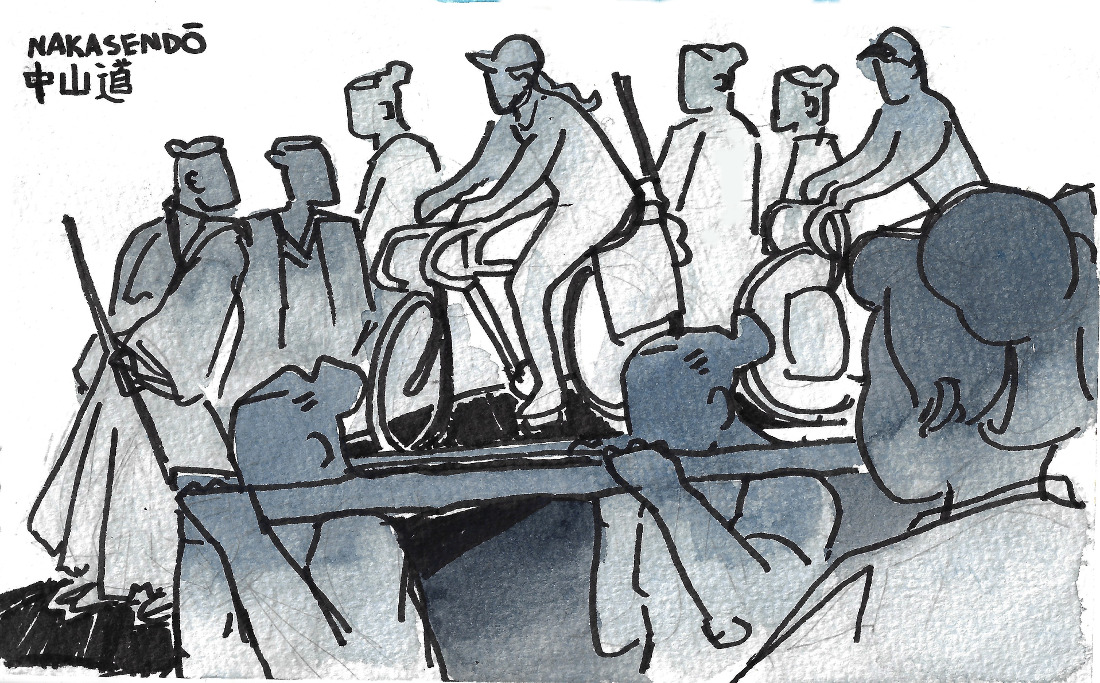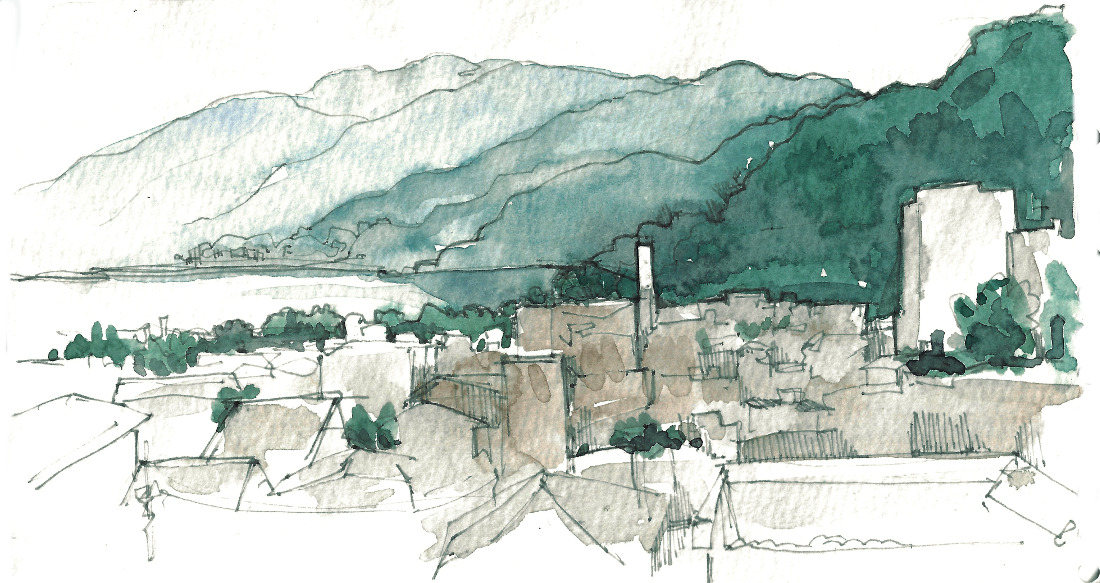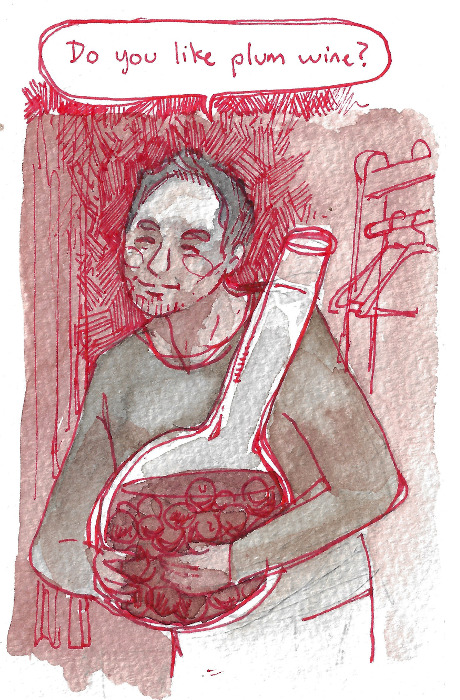Since the last blog post, we made it to Tokyo, and returned from our trip abroad. During the past month, we have been slowly adjusting to a stationary life.
Rumors of our demise have been greatly exaggerated. We’re both healthy and temporarily residing in Truro, Massachusetts. Amy is baking bread and making art, and I am working on carpentry projects and reading books from the nearby transfer station.
This will be part one of a three part series. Today I’ll cover the mad dash to Tokyo in more detail. The next post will detail the journey from Tokyo to Cape Cod. Finally, the third part of the series will be a post of reflections about our journey so far, and the psychological mechanics of returning.
The last blog post ended with us deciding to forego a leisurely few weeks in Shikoku in favor of biking through the mountains at breakneck speed back to Tokyo. This route would take us inland from Osaka, via Kyoto to lake Biwa, through Gifu, and Ena/Natsugawa, through Kiso to lake Suwa, then South and North again around the vertical scar of Mount Yatsugatake to Saku, then east to Shimonita, where we would enter the Kanto plain. We’d cross a large part of the plain to Koga, and then turn south along the Edogawa river levee path to Tokyo. This roughly follows the ‘Nakasendo’, or inland mountain route, used by travelers in pre-industrial Japan to avoid the numerous dangerous river crossings that would be entailed in following the coast.
On day one of the traverse, we crossed Osaka and worked our way inland, via the Kyoto region, to lake Biwa. The first half of the day was a slow urban crawl, then a speed up the river path. The second half of the day was a traverse through endless small cities. Just as we were approaching sunset, we arrived at lake Biwa, the largest body of freshwater in Japan. We crossed a bridge at a narrow neck of the lake, took a bath at a strategically placed onsen, and set up our tent behind some shrubbery at an abandoned golf course which had been turned into a city park on the shores of the lake.
The next morning, we could see lycra-clad road cyclists shooting past us, as the circumnavigation of Lake Biwa is a popular bicycling challenge. We joined the parade, and biked north and inland to Gifu. Gifu is famous for its cormorant fishermen, but we avoided the tourist area and stayed at a businessman’s hotel near the train station. After a poor nights sleep in a tent we were happy to have a full nights rest, but for whatever reason we didn’t sleep well, and it was only going to get worse.
After Gifu, we continued our traverse to Ena. at Ena, the elevation really started to pick up. We kept climbing, and despite our already significant elevation, we could see that we were surrounded by great mountains, crowding around us in a great ring. We chose to take route 19, even though we thought it would be a boring and high-traffic ride, since the alternative would have involved climbing 3000 meters in a single day or taking a 15 km expressway tunnel where bikes were explicitly forbidden.
Thankfully we were wrong about route 19. Even though it was a busy thoroughfare, with plenty of ‘japanamax’ trucks, the prefectural authorities had ensured that there was always a sidewalk paralleling the road. Thanks, bureaucrats! I think this had to do with its status as the historical Nakasendo route. Long distance inter city walking is fairly common in Japan, and they decided to make this route available. Given the mountainous terrain, route nineteen followed a steep river valley, first upriver, through a two kilometer tunnel to cut off the summit, then down again.
We desperately wanted to make it to Okaya before the heavy rain that was predicted for the next day at noon, so we went as far as we could on the first day, from just after dawn until after dusk, slept in the corner of a large, dark parking lot, then woke up before dawn, and continued our journey along the same road. It was with a great sense of relief that we beat the rain, which didn’t arrive until later that evening. We were safely ensconced in our hotel room by the time that the huge droplets of water came smashing down against our window, driven by gusts of wind.
Okaya was gorgeous, a mountain lake and the small city co-exist in a sizeable mountain canyon, drawing a lazy cresent shaped shoreline between them. We finally got the rest we had so desperately wanted in Okaya, and woke the next morning feeling refreshed.
The next leg of the journey was around the landscape of mount Yatsugatake, three or four mountain peaks that form a fence between Okaya and Saku. To get to Saku, we had to go south, along yet another river valley, then north again. We spent a lovely evening at the home of Tatsuya, his wife Izumi, and their noble dog Baron. Tatsuya regaled us with stories of his time as a wanderer in south east Asia, where he traveled on a folding bicycle through China, Burma, Thailand, including several months as a Buddhist monk subsisting off of rice alms at a monastery. He undertook this journey in his fifties, which left me with hope that I could be so healthy in my old age. His stories were embellished with home-fermented plum wine, all three of us squatting comfortably on pillows around a portable kerosene fireplace to keep out the alpine chill.
The next morning we climbed up towards the mountain so that we could more easily traverse around it, and restocked at a mountain themed gift shop! There was a mountain bakery with amazing rye bread and curry sandwiches, bento, and a jam station where we picked up some rhubarb preserves. The peak of elevation for the day, and probably for the entire mountain route, took place at a stock farm that was also a tourist attraction. From the southern slopes of Yatsugatake-yama we could see the pastures extending out and down, populated by happy looking livestock in the Swiss fashion. In the distance were the mountains that we weren’t climbing, the Japan Alps, still tipped with snow in late May.
After our lunch, we were propelled by gravity down the river valley almost all the way to Saku, then climbed back through another river valley, filled with enormous blossoming wisteria trees, through a helical series of tunnels to lake Arafune.
The following day was an onslaught of riding across the Kanto plain, through suburban, flat rice fields, for at least thirteen hours, ten of which was probably on our bicycles. At one point in the middle of the day, so tired that we were in danger of falling off our bikes, we lay down on the sidewalk and closed our eyes for fifteen minutes, before continuing. If we hadn’t booked our hotel for that evening, and if rain hadn’t been predicted for the day after next, we would have called it quits at some point in the afternoon. We got to our hotel in Koga at 9:45 PM and collapsed.
In contrast, the next day was relatively easy riding down along a river path to Tokyo. It was such a strange sight to see the skytree rising up out of the rice fields, reminiscent of seeing Austin rising out of the ranchland of central Texas; the city as an occupying force, usurping yet intimately affected by the biome on which it is situated.
We returned to the ‘Space Hostel’, where we stayed at the start of our trip, and the receptionists recognized us! They were happy to see us again, and we were happy to see them. Their warm welcome made our victory over the Nakasendo all the better.
-Jim




Thanks for the great entry Jim! Also I love the cartoony drawing with the enormous round bottom flask of plum wine.